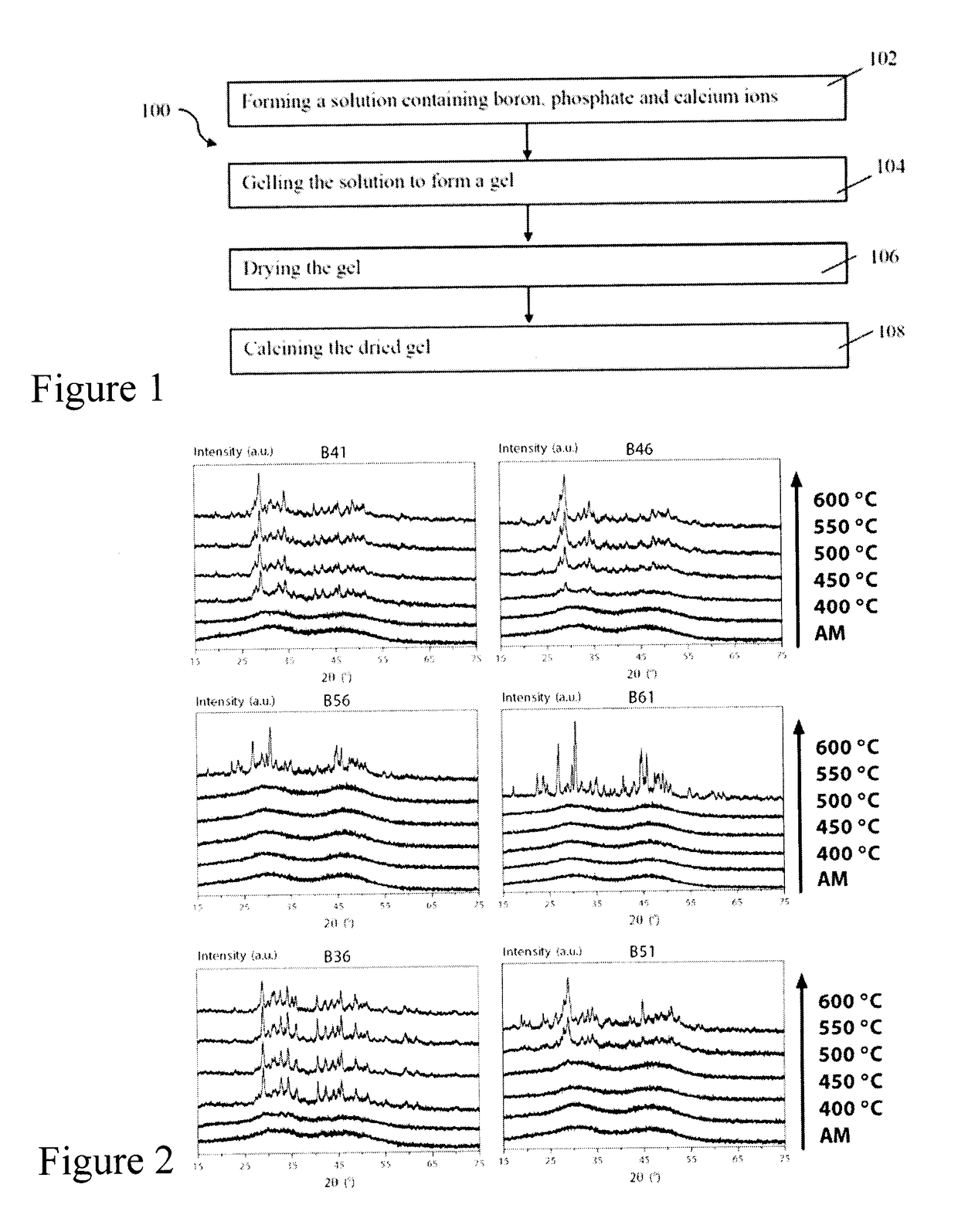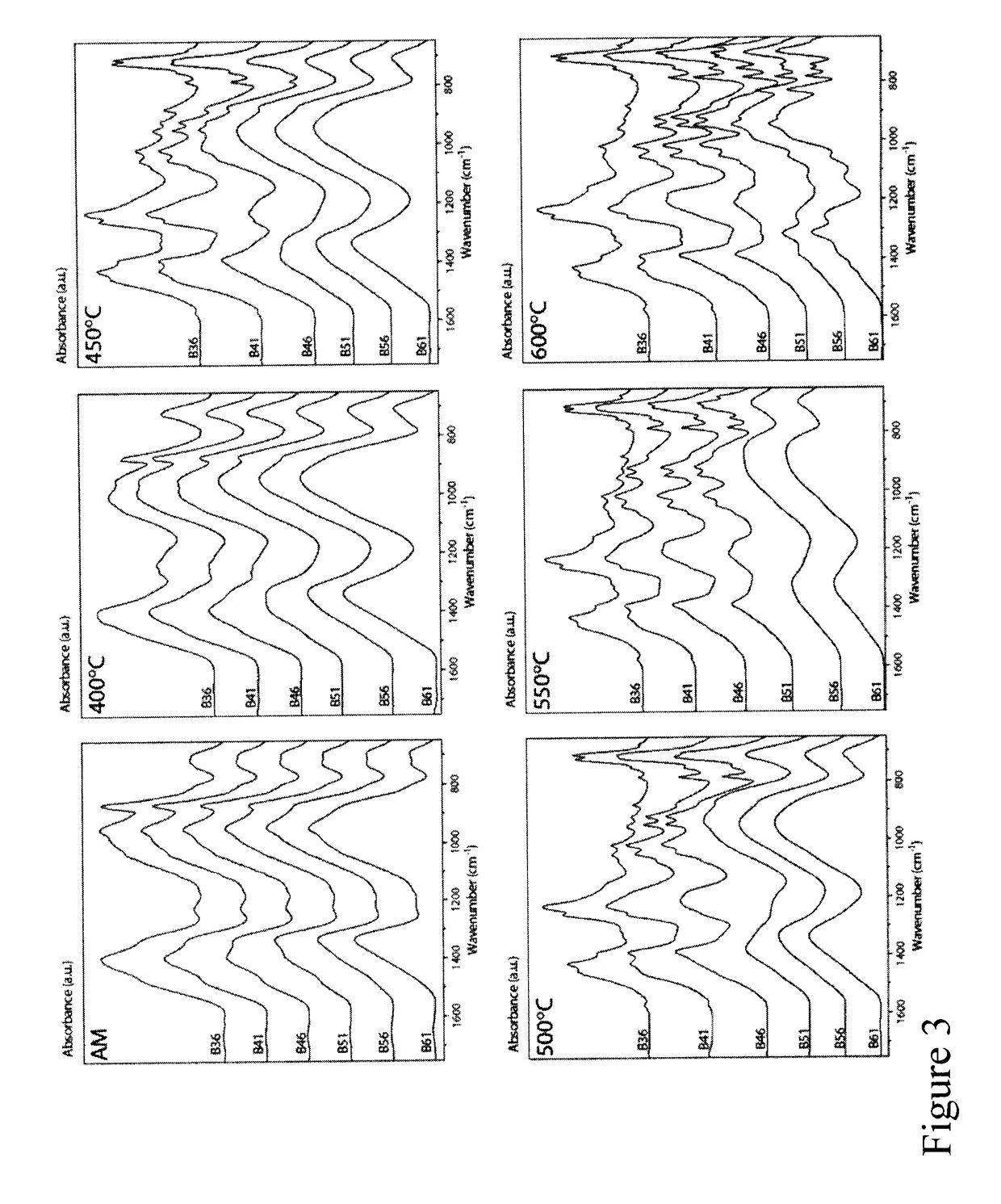Borate-glass biomaterials
a biomaterial and borate glass technology, applied in the field of borate glass biomaterials, can solve the problems of limited bioactivity in terms of slow mineralization, slow degradation behaviour of silicon-based glasses, and limited bioactivity of silicon-based glasses, so as to reduce skin redness, improve skin properties, and reduce the appearance of wrinkles
- Summary
- Abstract
- Description
- Claims
- Application Information
AI Technical Summary
Benefits of technology
Problems solved by technology
Method used
Image
Examples
example 1
Method of Making Borate-Glass Biomaterials
[0104]Borate-glass biomaterials, according to certain embodiments of the present disclosure, were made using a sol-gel process. All sol-gel processing took place within a nitrogen purged glove box. Four component borate glass compositions based on boron, Ca, Na and P were made by incrementally increasing or decreasing the amount of boron while maintaining the ratio of the Ca, Na, and P (Table 1). Boric Acid (>99.5%) was first added to anhydrous ethanol in a Teflon beaker which was covered with a watch glass, stirred magnetically, and heated to about 35-50° C., preferably 40° C.±3° C., to aid dissolution. Advantageously, unlike most known sol gel methods, a mild heating of about 35-50° C. suffices. After the solution became clear, triethyl phosphate (>99.8%), calcium methoxyethoxide (20% in methoxyethanol), and sodium methoxide (25 wt. % in methanol) were added drop wise in 30 minute intervals. After the final addition the solution was mixed ...
example 2
Comparative Example
[0110]To compare the effect of processing methods, a borate-glass biomaterial with a substantially equivalent composition (Table 2) to that of B46 of Example 1 was created using a melt quench technique. Boric Acid, monosodium phosphate, sodium carbonate, and calcium carbonate were thoroughly dry mixed and placed in a Pt crucible then heated at 1100° C. for 2 hours with intermediate stirring to insure homogeneity. The melt was then rapidly quenched between two steel plates and the resultant glass ground to 25-75 μm particles. The comparative biomaterial thus obtained, and the method used to obtain it, does not form part of the present disclosure and is included here for comparison purposes only.
TABLE 2Comparative example of melt-derived composition.wt. % (mol %)IDB2O3CaONa2OP2O5Comparative48.6 (46.1)22.9 (26.9)22.9 (24.4)5.6 (2.6)Example 45B5
example 3
Effect of Calcination Temperature on Crystallinity of the Glasses of Example 1
[0111]The effect of calcination temperature (400-600° C., and as-made (AM)) on structure for the sol-gel glasses of Example 1 was investigated using X-ray diffractometry (XRD). The sol-gel derived glass powders of Example 1 were analyzed with a Bruker D8 Discover™ X-ray diffractometer equipped with a CuKα (λ=0.15406 nm) target set to a power level of 40 mV and 40 mA. Using an area detector, three frames of 25° were collected from 15-75 2 theta) (°) and merged in post processing. Phase identification was carried out using X'Pert Highscore Plus™.
[0112]FIG. 2 illustrates the x-ray diffraction spectra for the compositions of Table 1. All the biomaterials of Example 1 were amorphous at a 400° C. calcination temperature which suggests homogeneity. Progressive crystallization was observed with increasing calcination temperature, with low borate content glasses crystallizing at lower temperatures. The lower boron ...
PUM
| Property | Measurement | Unit |
|---|---|---|
| Temperature | aaaaa | aaaaa |
| Temperature | aaaaa | aaaaa |
| Temperature | aaaaa | aaaaa |
Abstract
Description
Claims
Application Information
 Login to View More
Login to View More - R&D
- Intellectual Property
- Life Sciences
- Materials
- Tech Scout
- Unparalleled Data Quality
- Higher Quality Content
- 60% Fewer Hallucinations
Browse by: Latest US Patents, China's latest patents, Technical Efficacy Thesaurus, Application Domain, Technology Topic, Popular Technical Reports.
© 2025 PatSnap. All rights reserved.Legal|Privacy policy|Modern Slavery Act Transparency Statement|Sitemap|About US| Contact US: help@patsnap.com



